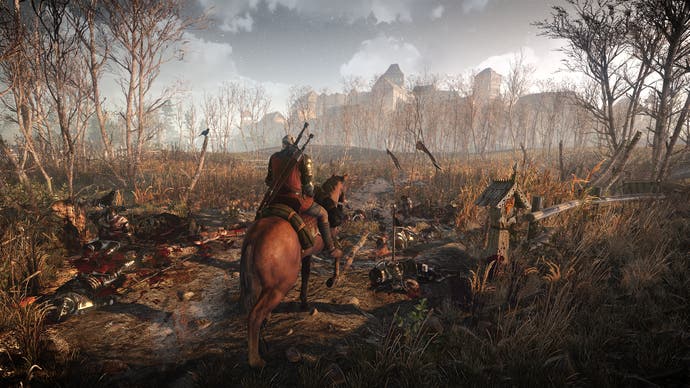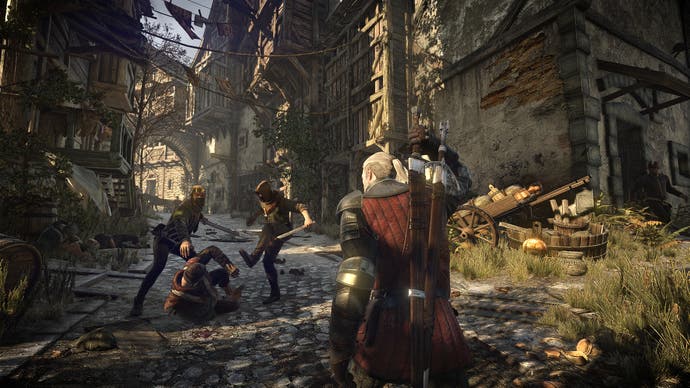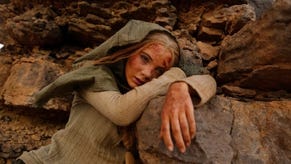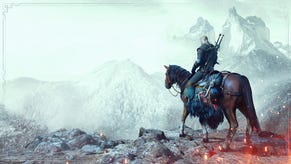The Witcher 3 is a masterpiece of world-building
Polish to perfection.
Editor's note: This is an early impressions piece based on our first week with The Witcher 3: Wild Hunt. We'll bring you our full review by the time of the game's launch on 19th May. We're taking the extra time to explore this vast game to the full - and to test a final, retail version, as per our reviews policy.
Open-world games are everywhere these days, and yet it's amazing how many struggle to shock their sprawling real-estate into life. While the likes of Watch Dogs might represent dazzling feats of engineering when it comes to spectacle and scale, move in close and they become dead-eyed facsimiles.
The Witcher 3 gets it right, reshaping and repurposing the series' war-ravaged fantasy land of Temeria into a seamless world that manages to feel complete, cohesive and, most importantly, a place where real life has unfolded and continues to do so. Not bad, when you consider that this is developer CD Projekt's first foray into open-world game design. Maybe that's the point.
On the surface, Wild Hunt is pretty standard fare, as far as the genre of free-roaming role-playing games goes. Like, say, Bethesda's Elder Scrolls series before it, the Witcher 3 coughs up an expansive, explorable fantasy kingdom, stuffs it full of stories and then sends you crisscrossing the continent, gathering quests that mix ample chat with magic-imbued hack-and-slash combat, all topped off with extensive character customisation.
However, while Skyrim (for all its majesty) often sent you on quests hewn from glum fantasy cliché at the behest of a series of plastic-faced nobodies, CD Projekt's work feels richer and more humane. If anything, Wild Hunt recalls Rockstar's cowboy epic Red Dead Redemption - and not just because both games let you trot about on horseback.

What it comes down to, I think, is that, like Red Dead, Wild Hunt offers an open world with a real sense of place. This is a game packed full of life and character that manages to remain focused and cohesive, despite its imposing scale.
From a purely aesthetic perspective, the Witcher 3 is gorgeous, of course, offering a wild world rich in detail and carefully primed ambiance. I've lost count of the number of I've stopped to gawp as the setting sun bathed the world in golden hues, or paused, captivated, as an incoming storm whipped through exposed boughs.
Temeria might be a grab-bag of fantasy tradition - as the titular, roguish Witcher, Geralt, you'll pass through misty swamps, ominous woods, sleepy hamlets and enormous cities on your travels - but everything feels like it has been placed with purpose and care. Regions flow organically into one another and crisscrossing quest lines do a masterly job of foreshadowing future events, guiding you past crucial landmarks - the looming battlements of a distant city, or a towering hillside rising awkwardly through swampy mist, adorned with a single gnarled tree - and offering tantalising glimpses of things to come.
Indeed, it's the game's intricately woven narrative threads that lend real impact to those undoubtedly pretty sights - and there's plenty to praise about Wild Hunt's light-footed script and winning voice work. The Witcher 3 hardly shies away from the trappings of the genre, but its world is painted with the kind of shade that you don't often see in big-budget games. Characters feel like people, with their own behaviours and motives, rather than mere ciphers for impending plot points, and there's both a bawdiness and lightness to proceedings that is disarmingly human.

CD Projekt's deft world-building finds a rare harmony between the landscape built by its artists and the stories being told by its writers. Castles and fortresses hothouse the political intrigue the Witcher series is known for, while folklore and heroism take centre-stage throughout the game's opening third, with the haunting wilderness expanse of Velen playing host to epic battles against mythical beasts and daunting treks through haunted ruins. Once you reach the sprawling city of Novigrad, however, the narrative adapts again, setting its sights on the more personal stories of the populace.
Wild Hunt's underlying systems aren't quite so strong, however. They're functional - and almost always enjoyable - but they frequently feel secondary to the broader adventures they serve. Combat, for instance - a crunchy mix of two-button sword-swinging and magic attacks - is knockabout fun and sometimes relatively strategic; while this is enough to see you through the game's surprisingly infrequent enemy encounters, it lacks the depth that some other RPGs offer.
Similarly, the game's generous customisation options - including merchant trading, weapon building, potion crafting and levelling - are nice (if somewhat fussy) inclusions, but they never become particularly compelling in their own right.
Instead, they exist to accentuate CD Projekt's unwavering dedication to freedom: to crafting a place that, while clearly defined, is still malleable enough to bend to your whims. This invariably brings us back to the stories at the heart of the game. They're rarely remarkable stories, but they are grounded and surprisingly human ones - as content dealing with flirtatious advances and everyday banality, or darker issues like domestic violence and child abandonment, as they are ancient evils and fairytale treasures.

Almost every story can be gently nudged in a new direction, too, and it's endlessly fascinating to see the ramifications of your words and actions ripple out across the land. What's especially interesting is the subtlety at play. The choices you make aren't often the heavy-handed, telegraphed conundrums of, say, Fable; sometimes a simple turn of phrase in a conversation tree can unwittingly send the dominoes falling.
You might make a new friend or a life-long enemy - and, sometimes, it's not readily apparent that you've had any effect at all. Even the more obvious choices you're presented with - would you care to rescue this man from a burning building, sir, or free this dark spirit trapped beneath the earth? - can splinter the game's quest structure into strange new pieces that snap back to reveal unexpectedly ambiguous conclusions.
Ambiguity and the messiness of human life. Games have already proven that they can build and populate open worlds, even worlds as majestic and romantic and wild as this one. But this stuff is a reminder that the Witcher 3 is trying to do something different. It is trying to make an open world feel convincingly inhabited, to give it the warp and weft of narrative history. That's a pretty interesting quest, and CD Projekt is a pretty interesting adventurer, beating a path into strange and bewitching new places. The result is that this Polish studio's first open world is one of the greatest we've ever seen.
If you've found yourself lost in this wonderful world, our Witcher 3 walkthrough is live now.









